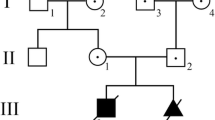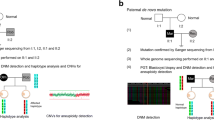Abstract
Objective
To explore inheritance of the m.3697G > A mitochondrial DNA (mtDNA) mutation and the effectiveness of preimplantation genetic diagnosis (PGD) for the carrier.
Methods
The study encompassed a pedigree of m.3697G > A mtDNA mutation, including one asymptomatic patient who pursued for PGD treatment. Twelve cumulus oocyte complexes (COCs) were collected in the first PGD cycle and 11 COCs in the second cycle. The efficiency of cumulus cells, polar bodies, and trophectoderm (TE) in predicting the m.3697G > A heteroplasmy of embryos was analyzed.
Results
From 23 COCs, 20 oocytes were fertilized successfully. On day 5 and 6 post-fertilization, 15 blastocysts were biopsied. The m.3697G > A mutation load of TE biopsies ranged from 15.2 to 100%. In the first cycle, a blastocyst with mutation load of 31.7% and chromosomal mosaicism was transferred, but failed to yield a clinical pregnancy. In the second cycle, a euploid blastocyst with mutation load of 53.9% was transferred, which gave rise to a clinical pregnancy. However, the pregnancy was terminated due to fetal cleft lip and palate. The mutation loads of different tissues (47.7 ± 1.8%) from the induced fetus were comparable to that of the biopsied TE and amniotic fluid cell (49.7%). The mutation load of neither cumulus cells (R2 = 0.02, p = 0.58) nor polar bodies (R2 = 0.33, p = 0.13) correlated with TE mutation load which was regarded as a gold standard.
Conclusions
The m.3697G > A mutation showed a random pattern of inheritance. PGD could be used to reduce the risk of inheritance of a high mutation load. Cumulus cells are not a suitable predictor of blastocyst mutation load.






Similar content being viewed by others
References
Goto Y, Nonaka I, Horai S. A mutation in the tRNA(Leu)(UUR) gene associated with the MELAS subgroup of mitochondrial encephalomyopathies. Nature. 1990;348(6302):651–3.
Rahman S, Blok RB, Dahl HH, Danks DM, Kirby DM, Chow CW, et al. Leigh syndrome: clinical features and biochemical and DNA abnormalities. Ann Neurol. 1996;39(3):343–51.
Osellame LD, Blacker TS, Duchen MR. Cellular and molecular mechanisms of mitochondrial function. Best Pract Res Clin Endocrinol Metab. 2012;26(6):711–23.
Zhang H, Burr SP, Chinnery PF. The mitochondrial DNA genetic bottleneck: Inheritance and beyond. Essays Biochem. 2018;62(3):225–34.
Gorman GS, Chinnery PF, DiMauro S, Hirano M, Koga Y, McFarland R, et al. Mitochondrial diseases. Nat Rev Dis Primers. 2016;2:16080.
Gorman GS, Schaefer AM, Ng Y, Gomez N, Blakely EL, Alston CL, et al. Prevalence of nuclear and mitochondrial DNA mutations related to adult mitochondrial disease. Ann Neurol. 2015;77(5):753–9.
Thompson K, Collier JJ, Glasgow R, Robertson FM, Pyle A, Blakely EL, et al. Recent advances in understanding the molecular genetic basis of mitochondrial disease. J Inherit Metab Dis. 2020;43(1):36–50.
Neupane J, Ghimire S, Vandewoestyne M, Lu Y, Gerris J, Van Coster R, et al. Cellular heterogeneity in the level of mtDNA heteroplasmy in mouse embryonic stem cells. Cell Rep. 2015;13(7):1304–9.
Heindryckx B, Neupane J, Vandewoestyne M, Christodoulou C, Jackers Y, Gerris J, et al. Mutation-free baby born from a mitochondrial encephalopathy, lactic acidosis and stroke-like syndrome carrier after blastocyst trophectoderm preimplantation genetic diagnosis. Mitochondrion. 2014;18:12–7.
Sallevelt SC, Dreesen JC, Drusedau M, Hellebrekers DM, Paulussen AD, Coonen E, et al. PGD for the m.14487 T>C mitochondrial DNA mutation resulted in the birth of a healthy boy. Hum Reprod. 2017;32(3):698–703.
Steffann J, Frydman N, Gigarel N, Burlet P, Ray PF, Fanchin R, et al. Analysis of mtDNA variant segregation during early human embryonic development: a tool for successful NARP preimplantation diagnosis. J Med Genet. 2006;43(3):244–7.
Treff NR, Campos J, Tao X, Levy B, Ferry KM, Scott RJ. Blastocyst preimplantation genetic diagnosis (PGD) of a mitochondrial DNA disorder. Fertil Steril. 2012;98(5):1236–40.
Assou S, Haouzi D, De Vos J, Hamamah S. Human cumulus cells as biomarkers for embryo and pregnancy outcomes. Mol Hum Reprod. 2010;16(8):531–8.
Olshan AF, Shaw GM, Millikan RC, Laurent C, Finnell RH. Polymorphisms in DNA repair genes as risk factors for spina bifida and orofacial clefts. Am J Med Genet A. 2005;135(3):268–73.
Negishi Y, Hattori A, Takeshita E, Sakai C, Ando N, Ito T, et al. Homoplasmy of a mitochondrial 3697G>a mutation causes Leigh syndrome. J Hum Genet. 2014;59(7):405–7.
Spangenberg L, Grana M, Greif G, Suarez-Rivero JM, Krysztal K, Tapie A, et al. 3697G>a in MT-ND1 is a causative mutation in mitochondrial disease. Mitochondrion. 2016;28:54–9.
Otten A, Sallevelt S, Carling PJ, Dreesen J, Drusedau M, Spierts S, et al. Mutation-specific effects in germline transmission of pathogenic mtDNA variants. Hum Reprod. 2018;33(7):1331–41.
Munne S, Blazek J, Large M, Martinez-Ortiz PA, Nisson H, Liu E, et al. Detailed investigation into the cytogenetic constitution and pregnancy outcome of replacing mosaic blastocysts detected with the use of high-resolution next-generation sequencing. Fertil Steril. 2017;108(1):62–71.
Uyar A, Torrealday S, Seli E. Cumulus and granulosa cell markers of oocyte and embryo quality. Fertil Steril. 2013;99(4):979–97.
Pan B, Li J. The art of oocyte meiotic arrest regulation. Reprod Biol Endocrinol. 2019;17(1):8.
Wang T, Sha H, Ji D, Zhang HL, Chen D, Cao Y, et al. Polar body genome transfer for preventing the transmission of inherited mitochondrial diseases. Cell. 2014;157(7):1591–604.
Taylor TH, Gitlin SA, Patrick JL, Crain JL, Wilson JM, Griffin DK. The origin, mechanisms, incidence and clinical consequences of chromosomal mosaicism in humans. Hum Reprod Update. 2014;20(4):571–81.
Funding
This study was supported by the National Natural Science Foundation of China (81871216, 81971455, U20A20350).
Author information
Authors and Affiliations
Corresponding authors
Ethics declarations
Conflict of interest
The authors declare no competing interests.
Additional information
Publisher's note
Springer Nature remains neutral with regard to jurisdictional claims in published maps and institutional affiliations.
Supplementary Information
Below is the link to the electronic supplementary material.
Rights and permissions
About this article
Cite this article
Ji, D., Li, X., Pan, J. et al. Preimplantation genetic diagnosis for a carrier with m.3697G > A mitochondrial DNA mutation. J Assist Reprod Genet 38, 3251–3260 (2021). https://doi.org/10.1007/s10815-021-02354-3
Received:
Accepted:
Published:
Issue Date:
DOI: https://doi.org/10.1007/s10815-021-02354-3




